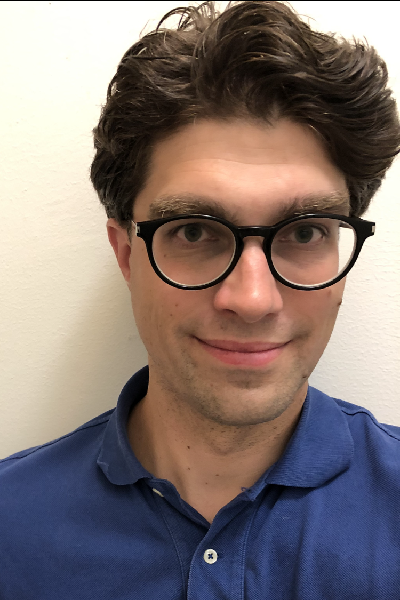Michael Landreh
Universitetslektor vid Institutionen för cell- och molekylärbiologi; Molekylär biofysik
- E-post:
- michael.landreh@icm.uu.se
- Besöksadress:
- Husargatan 3
752 37 Uppsala - Postadress:
- Box 596
751 24 Uppsala
- ORCID:
- 0000-0002-7958-4074
Mer information visas för dig som medarbetare om du loggar in.
Kort presentation
Denna text finns inte på svenska, därför visas den engelska versionen.
My research is focussed on mass spectrometry (MS), a technique that allows us to determine the exact weight of biomolecules, to study how proteins fold, interact, and function. I am particularly interested in proteins that are refractory to other structure analysis methods. Work in my lab includes protein condensates formed by liquid-liquid phase separation, membrane proteins and their interaction with membrane lipids, and proteins that form fibers, such as spider silk.
Forskning
Denna text finns inte på svenska, därför visas den engelska versionen.
Our research group focuses on the use of mass spectrometry (MS), a technique that allows us to determine the exact weight of biomolecules, to study how proteins recognise and bind their partners.
Mass spectrometry of protein interactions from cancer to memoryAll biological processes can be described as biomolecules “talking” to each other, providing cargo, information, or transportation. These events usually take the from of a direct physical contact, i.e. a non-covalent interaction, in which one molecule, most often a protein, binds to one or more partners, inducing a change in the three-dimensional structure. In this manner, proteins can keep in touch with their environment to control their function. For example, upon sensing a change in pH, sider silk proteins lock each other into infinite chains to form very stable scaffolds, and membrane proteins can recognise individual lipid molecules in their environment to tune their activity accordingly. Aberrant, -faulty- interactions, on the other hand, interfere with these processes and are therefore often associated with diseases. Some proteins interact with themselves and form toxic structures such as amyloid fibrils that eventually lead to degeneration of the affected tissue, as seen in e.g Alzheimer's disease. Similarly, destabilization and aggregation of the tumour suppressor p53 and its targets leads loss of cell cycle control and impaired DNA damage repair, giving rise to cancer. Therefore, it is important to understand how exactly proteins “talk” to each other, and use this information to find ways to prevent interactions from going wrong.
Our group focuses on the use of mass spectrometry (MS), a technique that allows us to determine the exact weight of biomolecules, to study how proteins recognise and bind their partners. MS is well-suited for the study of transient interactions, large complexes and even unstable proteins, all of which are refractory to other structural biology methods like NMR and X-ray crystallography. For this purpose, we combine several complementary approaches:
- In “native” MS, we gently transfer proteins together with their binding partners from physiological solutions into the vacuum inside the mass spectrometer and measure the weight and stability of the resulting complex. This reveals what type of interaction holds the partners together, and how many (and which) molecules are involved.
- Hydrogen/deuterium exchange MS measures the incorporation of a chemical label (Deuterium) into the protein. Deuterium is incorporated into flexible and exposed parts of the protein. By measuring the resulting increase in weight, we are able to determine the stability and folding state of a protein, and even locate binding sites for tother proteins.
- MS-based proteomics allows us to identify individual proteins from complex mixtures based on their unique mass “fingerprints”. Using individual proteins as bait, we are able to fish out their specific interaction partners and map upstream and downstream targets.
The combination of all three techniques provides direct insights into several aspects of an interaction, but also generates constraints that can be used to direct computational modelling.
Group ProjectsAggregation-prone proteins are related to a number of diseases such as neurodegenerative disorders, hereditary cancers, and interstitial lung disease, yet remain among the most challenging targets for structural biology. Many of these proteins use liquid-liquid phase separation (LLPS) to form membraneless organelles, but how the assembly of partially disordered proteins generates functional compartments in the cytoplasm and particularly in the nucleus is poorly understood.
Our group uses native mass spectrometry and ion mobility to probe the structures of proteins in membraneless organelles by releasing them from their native assemblies inside the mass spectrometer. Mass spectrometry data are complemented with atomistic and coarse-grained MD simulations, cryo-electron microscopy, and AI-guided structure predictions, to yield detailed models of proteins in native assemblies. We aim to assemble complete models of membraneless organelles that can open new avenues for drug development in cancer and neurodegeneration.
Membrane proteins constitute up to 60% of all drug targets, yet their location in the cell membrane makes studies of their native structures and interactions difficult. We use MS to understand how lipids affect the stability and function of proteins in the lipid bilayer. Current projects include the use of designed membrane proteins to extract first principles of lipid recognition, and how specific lipids can tune the internal dynamics of their target. Together with David Drew and Erik Lindahl at Stockholm University, we investigate the roles of lipids in transporters and ligand-gated ion channels.
A significant part of this work is the development of new mass spectrometric methods, as well as fundamental studies on the mechanisms of ionization and structures of proteins in the gas phase. We routinely use protein engineering and computational chemistry to find new ways to study protein structures and interactions by mass spectrometry.
We collaborate with David Drew and Erik Lindahl (Stockholm U) on membrane protein-lipid interactions, Erik Marklund (Uppsala) on integrating MS and MD simulations, Carol Robinson and Justin Benesch (Oxford) on MS method development, and Jan Johansson (KI) and Anna Rising (SLU) on strategies against amyloid formation, and the biology of spider silk production.

